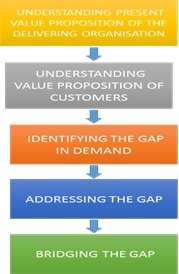All Businesses exist to generate profit for the organization by creating values for its customers. C.K. Prahalad in his article titled “The fortune at the bottom of the pyramid” brought out the importance of unattended segments comprising of low income group in business pyramid and wrote that “Low income markets present phenomenal opportunities for the wealthiest companies not only by seeking fortune from those customers but also bringing prosperity in those sections by addressing their unmet demands efficiently.”
Premium quality product manufacturers, whose products are highly priced catering to the high end customers, find that Base of the Pyramid markets are less attractive and customers are less creditworthy than customers in top tier business segments. The bottom of pyramid customers, i.e. tier 3 customers from B2B segments are characterized by lower sales turnover, scale of operation, lower profits compared to tier 2 and tier 1 segments and penetrating that market with a premium product needs a lot of analysis and this article will attempt to show how to penetrate this market and aid in market development by addressing the needs of the unmet demands of these customers and effectively satisfying the demand.
Identifying the value Proposition of the customers:
Value proposition can be defined as promise of value that should be delivered to the customers. The value proposition can be of tangible form which can be product size, features, efficiency, performance, durability, etc or can be of intangible form which may consists of delivery, installation, customer feedback, after sales service. The right mixture of this value proposition will result in benefit maximization and cost minimization which best supports customers buying decision.

As shown in the figure above, organization wanting to make a difference in the Bop segments must analyze its present value proposition with that of customer requirements and suitably structure its offerings in such a way that the gap is bridged and ultimate benefit maximization is realized. What customer values most can be gathered by questionnaire and feedback form and assigning weights on those values which customer ranks high. Quantifying the values enables organizations to have a more refined method of selecting the value proposition.
Create Financial Avenues to Induce Buying:
One of the premium automotive manufacturer, Volkswagen, has recently launched a Star lease option in which customers can lease premium cars by paying monthly rentals and pay as long as they are willing to use the car. Leasing provides the customers a benefit of access to a product without investing 100% of the value of the product and option to pay rentals as per customer’s convenience and creditworthiness. By providing such options customer’s buying power is indirectly increased and new markets can be developed by addressing the financial needs of the customer in the untapped market. Leasing can also be beneficial to the Leasing company ( here Volkswagen) in which the rentals received are return on their assets and claim depreciation benefits in their books.
Ministry of Micro Small Medium enterprise (MSME-Government of India) has introduced schemes like CLCSS (Credit linked capital subsidy scheme for technology up gradation) to facilitate small scale Government identified SSIs to equip/ upgrade with proven technologies by contributing 15% capital subsidy and providing loan up to INR 1 crore. The above financial schemes will help the tier 3 customers in b2b segment to get access to latest technology and premium product. Thereby these schemes can become a source of market development.
Product Differentiation in the B2B industry:
In conventional B2B marketing, product differentiation as a marketing strategy is always associated with increasing or enhancing the performance of the product.For example take the case of Industrial pumps. The core function is to pump the liquid and transport it to the desired location either horizontally or vertically. Here B2B manufacturers have always relied on increasing the life of pumps and better performance by making improvements in impeller design, motor and pump efficiency. But increasing the efficiency beyond a point is not necessary and customer may not be willing to pay for it where augmentation is beyond expectation.A product with enhanced performance but with poor after sales service might result in customer perceiving the product as low value in spite of the product having enhanced efficiency. B2B segments now suffer from less number of customers as there is an increase in competition within the business segments and there is an increasing pressure on the organization to differentiate their product features through innovation. Innovation need not be Research and Development. Innovation need not be expensive. Small improvements over time may help organization sustain its competitive position over a longer period of time.
One novel idea is to maintain customer relationship management through mobile phones. Mobile phones are ubiquitous innovations of the 21st century. For tier 3 customers who may not be inclined to buy costly CRM software’s , mobile communication would be a lot cheaper and faster method of addressing the customer’s service related enquiries and maintaining relationships. Instead of having an expensive computer to handle transactions and enquiries, customer can send a text message for service related enquiries.With mobile network service providers coming out with more value added services like mobile banking, 3G services and bringing in more flexibility and customization so as to suit individual customer’s needs, in similar manner business transactions can be personalized according to requirements of tier 3 customers.
Conclusion:
Tier 3 segments poses a lot of challenges for market development. The initiation to adoption process in BoP segments is a lot challenging. Customer’s creditworthiness, business volume, company history has to be carefully evaluated. Business corporations who would want to develop markets in low tier segments must become a complete solution provider than mere product sales activity. Evaluating the customer’s requirements plays a crucial role because the organizations which best meets the customer requirements in a longer run will be successful in developing a larger market share.
[The article has been written by Krishnakumar Nallu. He is presently pursuing his PGDM in Thiagarajar School of Management, Madurai]

































